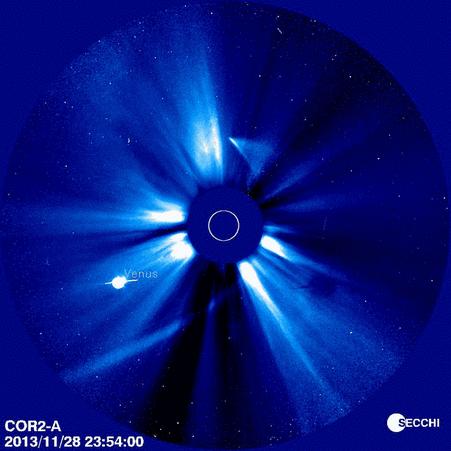
Laura Nielsen for Frontier Scientists –
Last Thursday, while many gathered with loved ones for Thanksgiving, a frozen ball of ice and rock was hurtling towards the Sun reaching speeds of 225 miles/second [360 kilometers/second]. A fleet of solar-observing spacecraft had their instruments aligned, and experts were on hand to watch what unfolded. We wondered whether Comet ISON would survive its close pass with the Sun or burn up.
Watching ISON
Astrophysicist Karl Battams writes about the experience of waiting to learn ISON’s fate after the comet reached perihelion (its closest approach to the Sun, a mere 683,508 miles [1,100,000 kilometers] away). He writes: “We feared the worst as ISON plunged through the solar corona, and while our hopes were briefly raised when something emerged from behind the solid LASCO C2 occulting disk, it soon became apparent that ISON was no longer a healthy comet.” (An occulting disk is a metal plate that blocks out the direct light of the Sun so sensitive instruments can better view solar storms and other near-Sun activity: the solar corona.)
With such a close approach to the Sun, the ball of rock, ice and dust faced temperatures hot enough to vaporize solid matter. It also battled the Sun’s savage gravitational forces. Since we started observing it, ISON has always been a dynamic and unpredictable comet, and its solar pass was no different. As ISON entered the solar atmosphere and rounded the Sun on Thanksgiving its tails of gasses and dust released by melting ice and disintegrating matter disappeared. We knew when ISON should become visible again, but none of the sensitive instruments that detect oxygen atoms (escaping superheated water) aboard the Solar Dynamics Observatory and the European PROBA2 spacecraft could see anything. It was strange, then, that hours later ISON began to once more emit a cloud of gas and dust. The cloud was dimmer, but present. You can see it in the image above, and in animated images collected by various spacecraft.
Unprecedented views
For more views like the image at the start of this article, visit the Comet ISON Observing Campaign, where Karl Battams has posted beautiful GIFs from NASA’s STEREO instruments of ISON’s pass around the Sun. Credit to NRL/NASA
Also watch NASA’s feature video ‘Comet ISON’s Full Perihelion Pass’ with images from the Solar Terrestrial Relations Observatory (NASA) and the Solar & Heliospheric Observatory (ESA/NASA). The video shows Comet ISON approaching and then dimming dramatically as it curves away from the Sun. Credit to ESA/NASA/SOHO/STEREO/GSFC
Word from NASA
On December 2nd NASA released this statement: “There’s no doubt that the comet shrank in size considerably as it rounded the sun and there’s no doubt that something made it out on the other side to shoot back into space. The question remains as to whether the bright spot seen moving away from the sun was simply debris, or whether a small nucleus of the original ball of ice was still there. Regardless, it is likely that it is now only dust.” The word is that ISON is no more. There may be still-disintegrating fragments of the comet left, but no central nucleus (core) remains to make ISON a true comet.
The journey
ISON was created 4.5 billion years ago and began its journey from the Oort Cloud perhaps 3 million years ago. It approached our Sun, giving us spectacular astronomical images on its way by. If any fragments survive until December 26th, 2013, they will fly by our planet 40 million miles [about 64 million kilometers] away on their way back to the outer reaches of the solar system. We might get to see some of that ghostly cloud of gas, dust and stone in late December, when any fragments of the comet’s nucleus that still exist will enter the Hubble Spacecraft’s field of view. An important caveat: ISON might surprise us still. Perhaps a small nucleus still does exist, perhaps not.
The takeaway
Though we won’t get to see the spectacle of a healthy Comet ISON flying away, and we don’t know whether ISON’s remains will be visible to the naked eye from Earth, we have gained a great deal of knowledge. With so many spacecraft, observatories, and astrologers training cameras and eyes to ISON’s progress we have gained an enormous cometary data set. With that data we will learn a great deal about matter in the early solar system, comets, and our star’s solar atmosphere and immense power.
“Comet ISON leaves behind an unprecedented legacy for astronomers,” and a global audience, Karl Battam says. Here’s his call to action: “In ISON’s memory, donations are encouraged to your local astronomy club, observatory or charity that supports STEM and science outreach programs for children.”
Frontier Scientists: presenting scientific discovery in the Arctic and beyond
References:
- ‘Comet ISON Is No More, NASA Says’ Mark Memmott, NPR (Dec 2, 2013)
http://www.npr.org/blogs/thetwo-way/2013/12/02/248202813/comet-ison-is-no-more-nasa-says - ‘In ISON’s Wake, a Trail of Questions’ Karl Battams, CIOC: NASA Comet ISON Observing Campaign (Nov 29, 2013)
http://www.isoncampaign.org/karl/a-trail-of-questions - ‘NASA Investigating the Life of Comet ISON’ NASA (Dec 2, 2013)
http://www.nasa.gov/content/goddard/nasa-investigating-the-life-of-comet-ison/#.Up1mtcTrw3U - Perihelion & Distance: LIVE Information’ Comet ISON 2013 (2013)
http://www.cometison2013.co.uk/perihelion-and-distance/ - ‘Three Eyes on ISON’ Karl Battams, CIOC: NASA Comet ISON Observing Campaign (Dec 1, 2013)
http://www.isoncampaign.org/potw-dec02